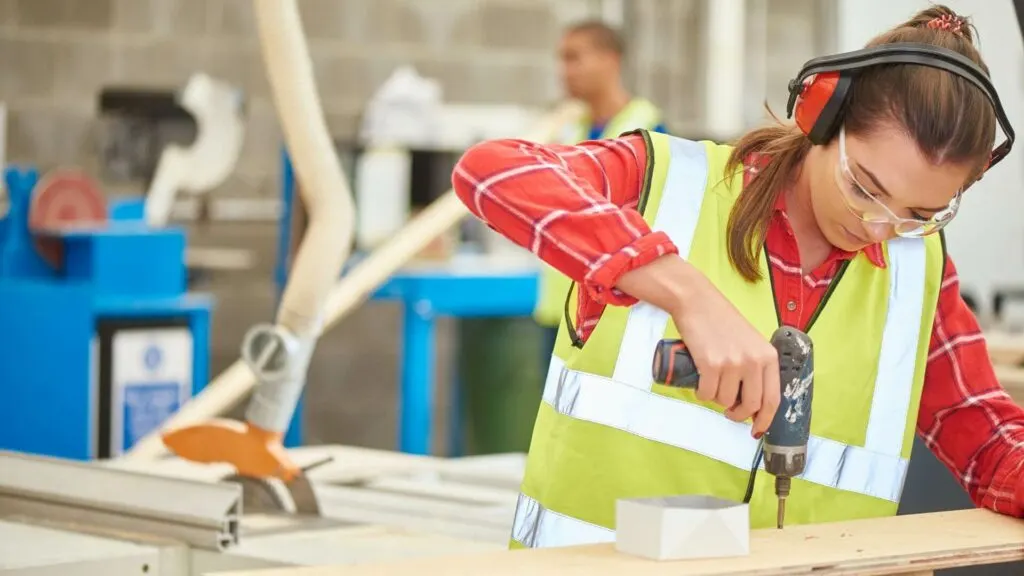Imagine you’re planning to transform your living space or perhaps craft a custom piece of furniture. Who do you call? A carpenter—a skilled craftsperson capable of turning simple wood into functional art. Carpenters are the backbone of any construction project, from framing houses to creating intricate furniture that enhances your home’s aesthetics.
Carpenters possess a diverse skill set, enabling them to work on various projects across residential and commercial construction. Whether it’s building from scratch or repairing existing structures, these professionals ensure everything is structurally sound and visually pleasing. Understanding what carpenters do and the skills they bring can help you appreciate the craftsmanship behind the everyday structures around you.

Understanding the Role of a Carpenter
Who Is a Carpenter?
A carpenter is a skilled tradesperson who works with wood and other materials to construct, install, and maintain buildings, furniture, and other structures. The role extends beyond simple woodwork; carpenters also engage in planning, measuring, and creating frameworks that contribute to both the functionality and aesthetic qualities of various constructions. Carpenters play an essential role in various stages of building projects—from the initial framework to the final touches of a structure. Mastery in using tools like saws, hammers, and drills is crucial for their craft.
The History and Evolution of Carpentry
Carpentry is one of the oldest trades in the world, dating back thousands of years when the first tools were used to shape wood. Originating from ancient techniques, carpentry evolved significantly around the 6th century with the introduction of more complex tools and joining methods. As civilizations grew and technology progressed, the role of carpenters became more specialized, paving the way for advancements in construction and architecture. During the medieval period, guilds were established to develop and preserve the skills needed in carpentry, ensuring that knowledge passed down through generations maintained high standards of quality and intricacy.
Skills and Tools of the Trade

Continuing from the historical context and the pivotal role of carpenters in construction, this section dives into the essential skills and tools that define a carpenter’s workmanship. As a professional in the field, mastery over these skills and tools amplifies your ability to handle diverse projects with precision and creativity.
Essential Carpentry Skills
Proficiency in a variety of carpentry skills separates the novice from the expert. The primary skill rests in Measuring and Cutting, where accuracy ensures the materials fit perfectly, minimizing waste and enhancing structural integrity. Installation Techniques come next, as you’ll often install frameworks, including windows and molding, requiring meticulous attention to detail to achieve the desired aesthetic and functional outcome.
Effective Problem Solving is vital, as every project presents unique challenges that require innovative solutions, often under tight deadlines. To complement these, Mathematical Skills are necessary for calculating dimensions, slopes, and angles. Communication and Teamwork cannot be overstated, as straightforward collaboration and clear instructions significantly impact the project’s efficiency and success.
Tools Every Carpenter Should Know
Your toolkit is your best asset. Familiarity with the following tools not only ensures quality but also safeguards efficiency:
- Saws (Table Saws, Circular Saws, Jigsaws): Vital for making precise cuts in various materials.
- Hammers and Mallets: Used for driving nails, fitting parts, and breaking objects.
- Chisels and Planes: Essential for shaping and smoothing surfaces.
- Measuring Tapes and Squares: Critical for precise measurement to ensure symmetry and balance.
- Levels and Plumb Bobs: Ensure that constructions are plumb and level, which is crucial for structural stability.
Understanding and utilizing each tool effectively allows you to maneuver through tasks with skill and confidence, leading to successful, high-quality projects. Each tool serves a specific purpose, and knowing when and how to use it is paramount, reflecting your expertise and dedication to the craft.
Types of Carpentry

Carpentry plays a pivotal role in both residential and commercial construction, adapting to the needs of each sector with specialized skills and techniques. As a continuation of mastering essential tools and techniques, carpenters further differentiate their expertise based on the settings they work in and the specific tasks they perform.
Residential vs. Commercial Carpentry
Understanding the distinction between residential and commercial carpentry is crucial, as each requires unique skills and approaches. Residential carpenters focus on homes and small housing projects. They engage in constructing, erecting, installing, and repairing structures and fixtures made of wood and other materials. Often, these carpenters are involved in detailed work such as building custom cabinets, installing doors and windows, and crafting furniture tailored to personal tastes and home aesthetics.
Commercial carpentry, however, operates on a larger scale involving projects like office buildings, schools, hospitals, and malls. These carpenters handle more robust construction tasks, focusing on aspects like metal framing, concrete formwork, and building exteriors. Commercial projects require carpenters to read and interpret blueprints and work closely with engineers and architects to ensure structures meet legal and safety standard requirements.
Specializations Within Carpentry
Carpentry encompasses a range of specialties, each demanding a specific set of skills and knowledge. Some of the most recognized specializations include:
- Rough Carpentry: Often referred to as framing, rough carpenters concentrate on building skeletal structures of buildings. They lay out the basic frame, ensuring accuracy and stability that will support the entire structure.
- Finish Carpentry: Focusing on aesthetics, finish carpenters work on the trimming, molding, and fine details that give a space its character. This specialization requires a keen eye for design and precise handiwork.
- Cabinetmaking: A specialization that combines elements of woodworking and fine craft, cabinetmakers design, construct, and install cabinetry tailored to client specifications. This role demands a blend of creativity and technical skill to produce both functional and beautiful pieces.
- Ship Carpentry: Specializing in maritime needs, ship carpenters build and repair boats and ships. This niche requires knowledge of marine safety and construction techniques unique to water-bound vessels.
Each specialization in carpentry not only enriches the field but also offers you diverse opportunities to excel and innovate, whether working on intimate residential projects or undertaking large-scale commercial constructions. By choosing a specialization, carpenters can concentrate on refining their skills in a particular area, enhancing both their efficiency and craftsmanship in their chosen niche.
Education and Certification

How to Become a Carpenter
Becoming a carpenter starts with a combination of formal education and hands-on training. Typically, you’ll need a high school diploma or equivalent to begin. Education in basic mathematics, science, and technology offered in high schools lays a strong foundation. Many aspiring carpenters then enroll in vocational schools or community colleges, where they receive more focused training on carpentry techniques and tools.
Apprenticeships form the core of carpentry training, blending classroom learning with real-world experience. These programs usually last three to four years and are offered by trade unions or contracting companies. As an apprentice, you’ll learn essential skills such as blueprint reading, building code requirements, and safety practices while gaining practical experience under the supervision of experienced carpenters.
Importance of Certifications in Carpentry
Certifications in carpentry serve as benchmarks of skill and knowledge that can greatly enhance your career. Though not always mandatory, having certifications can differentiate you from other professionals in the field. One recognized certification is the National Association of the Remodeling Industry (NARI) certification for carpenters. This certification requires passing an exam that covers a broad range of carpentry skills and adhering to a professional code of ethics.
Additionally, the Occupational Safety and Health Administration (OSHA) offers safety certification programs. These programs focus on crucial safety practices and regulatory compliance, ensuring that carpenters understand how to maintain a safe working environment. Possessing OSHA certifications not only boosts your employability but also demonstrates your commitment to maintaining safety standards on the job site. In summary, certifications not only validate your expertise but also open up more opportunities for career advancement and security in the highly competitive field of carpentry.
What Is a Carpenter? Guide to Becoming a Carpenter
Embarking on a carpentry career is more than learning a trade; it’s embracing a tradition of craftsmanship that dates back centuries. With the right education and certifications, you can not only master the essential skills but also stand out in a competitive field. Whether you’re aiming to create stunning wooden structures or seeking to innovate within the construction industry, your journey as a carpenter will equip you with the tools to build a successful future. Remember, the path involves dedication and continuous learning, but the rewards—both personal and professional—are immense.
Frequently Asked Questions
What is the historical significance of carpenters in construction?
Carpenters have been integral to construction for centuries, known for their craftsmanship and ability to transform wood into functional art. Their skills have played a crucial role in building structures that are both practical and aesthetically pleasing.
What are the essential skills needed for carpentry?
Carpentry requires proficiency in measuring, cutting, and problem-solving. Mastery of various tools is also vital, as it ensures that carpenters can perform tasks efficiently and with precision.
How can one become a carpenter?
To become a carpenter, one usually starts with formal education through vocational schools or community colleges, followed by hands-on training. An apprenticeship is essential, combining classroom lessons with real-world construction experience under supervision.
Why are certifications important in carpentry?
Certifications in carpentry, such as those from NARI and OSHA, validate a carpenter’s skills and knowledge, enhance career prospects, and ensure adherence to safety standards in the workplace. They are crucial for professional growth and maintaining high standards within the industry.

Jessi is the creative mind behind The Coffee Mom, a popular blog that combines parenting advice, travel tips, and a love for all things Disney. As a trusted Disney influencer and passionate storyteller, Jessi’s authentic insights and relatable content resonate with readers worldwide.
